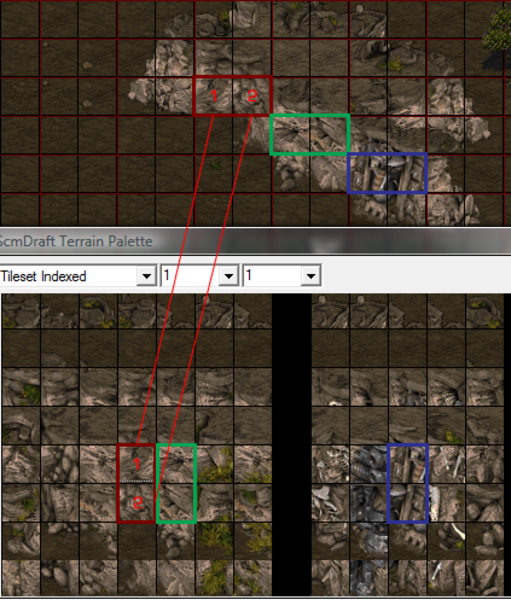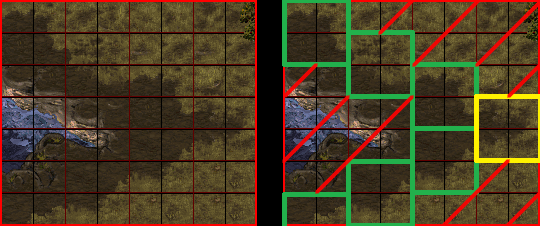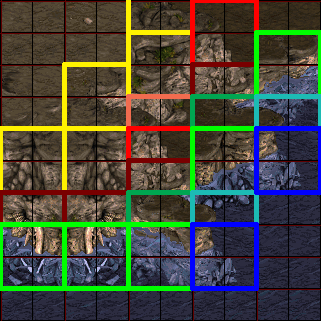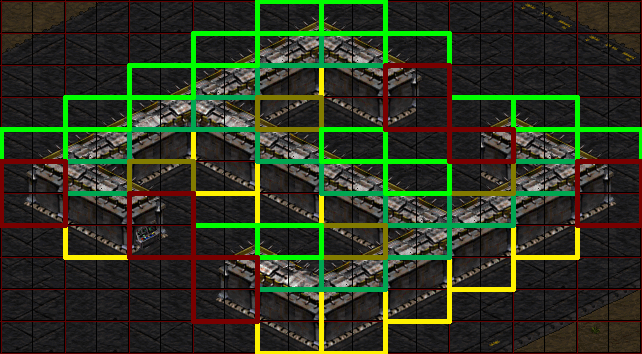Terrain Blending
As you know, custom terrain blending is about remixing individual tiles from the tileset's palette in ways that bypass the constraints imposed by editors' regular, isometric terrain painting. It's surprisingly easy, once you understand it. Seeing all the scattered jigsaw puzzle pieces in the tileset index can be intimidating at first, but once you understand how these tiles fit together, you'll have nailed one of the key elements of custom blending!
Contents
Basic Isometric Structure Makeup
Introduction to Pairs
The best way to explain the concept of terrain 'pairs' is to play around with the Subtile tool. All isometric terrain is comprised of these pairs. The tiles in each pair, in turn, is mapped in a column in the tileset index:
Pair Groups
While individual tiles come together to make each pair, pairs themselves often come together to make terrain groups. For example:
Advanced Isometric Structure Makeup
You begin to appreciate the beauty of the isometric system when you start to see how the more complicated isometric terrain blends are handled.
That's grass terrain over cliff edge section over an intermediate cliff subsection over water cliff over water.
And it gets even better:
Note: These representations may not be completely accurate.
As you can see, corners, compound cliffs, concave bends, and thin strips are where the isometric system's use of pairs gets somewhat messy. In the latter example, the previous notion of 2x3 walls deteriorates completely as the tops of walls squeeze together and join into corners. But fear not! If you're starting by now to get the gist of how Starcraft handles this stuff, then that's good enough. Let's move on to some handy tricks for working with tiles; the meat and bones of all blending!
Tileset List
Before we can get to any sort of blending, let's get a little better acquainted with navigating the tile list, first. Obviously, scrolling through gobs of tiles to find individual pieces to fit into a blend is going to be tedious no matter how you cut it. However, as we've already covered isometric basics, I can move on to explain a few things that will make this process a bit easier.
Firstly, remember that pressing Ctrl+click on any tile while under the Tileset index mode will seek out that tile in the list. This is important. Take some time using this to explore your terrain's tiles in the list for a while. Sense any patterns? Here, I'll list them:
- Each row of tiles for a piece of isometric terrain are related. That is, each tile generally corresponds to one of the different Subtile options available for that tile of a given pair. Try swapping out tiles of your terrain with tiles from their corresponding rows to see how many you can make accidentally blend together. You're now doing your very first rudimentary blending!
- Columns of tiles in the list correspond to pairs or pair sets. For instance, pick any 2x3 section of a wall or cliff, and Ctrl+click the terrain tiles of the 2x3 area from right to left, top to bottom. Watch how the tileset list scrolls down 1 at a time along the same column for the whole terrain chunk. There are exceptions to this pattern, but generally you'll find the tile pair sets of each given section of terrain arranged in columns like these.
- For each given isometric terrain tile, there will nearly always be an equivalent, mirrored tile listed somewhere nearby. Getting a sense of where these usually are will make mirroring your blends a bit easier.
- For each distinct isometric terrain type, you'll find them organized into groups in the vertical list. Even without memorizing each group, you generally know that you can start looking for like-tiles within a given like-group.
- Blizzard wasn't very efficient with their tile use, and as such, you'll find a lot of redundant repeat tiles floating around. When looking for tiles for a blend, it really doesn't matter which of these you pick to use.



